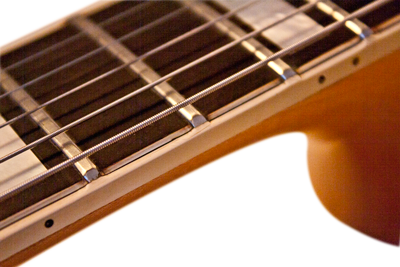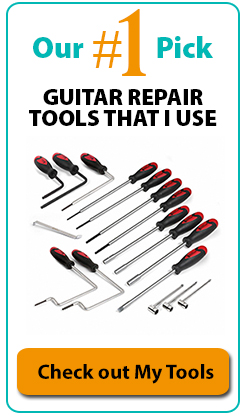
Fretboard binding is very similar to guitar body binding except it is on the side of the fretboard instead of the body. Fretboard binding gives the guitar fretboard clean lines and makes the guitar look great. Most of the time bound fretboards require no attention at all, but what happens when something wrong happens? In this article, we’ll talk about what fretboard binding is and how to repair it when it comes loose.
Acoustic guitar fretboard binding is basically the same as the binding around the guitar’s body. Fretboard binding is a thin strip of material that is glued around the outside of the fretboard. It is most often made out of plastic, but it can be made out various woods, plastics, and celluloid. Fretboard binding serves no structural purpose like the body binding does. The only reason for having binding around the fretboard is to look good. Binding around the outside of the fretboard covers the ends of the frets. Binding also frames the fretboard nicely. Bound fretboards often feature abalone or purling inlays around the outside of the fretboard for decoration like the picture above.
How to fix Loose Fretboard Binding.
Contents
What causes Loose Fretboard Binding.
Fretboard binding can have many of the same problems that body binding has. It can break, crack, deteriorate, and shrink. The most common cause of loose or cracked binding is usually a combination of things. The most obvious causes are abuse and poor conditions. Since the binding on the edge of the fretboard is exposed, it is fairly easy to bump or drop your guitar and damage the binding.
Loose fretboard binding also occurs in dried out guitars just like with body binding. The guitar wood shrinks when it dries out. The binding is forced to follow the contour of the shrinking guitar wood because it is glued to the guitar. Normally, this isn’t that big of a problem, but fretboard binding also has to contest with the frets. The metal frets that are inlayed in the fretboard are not forced into the shape of the guitar wood. The frets do not expand and contract nearly as much as the guitar wood does. So when the guitar wood shrinks, the frets remain the same size. The frets, then, stick out either side of the fretboard. On an unbound fretboard this normally would not be a big deal. You would just have to file down the edges of the frets and get back to playing. A bound fretboard is quite a different story. The binding is glued to the outside of the fretboard. When the frets stick out of the shrunken fretboard, they push the binding away from the fretboard causing the binding to come loose.
Frets and loose fretboard binding can be a hassle if you don’t know what you are doing. Here are some practical steps to repairing loose fretboard binding on your acoustic guitar.
Remove the Frets.
In most cases, it will be impossible to repair the loose fretboard binding without removing some or all of the frets. If the binding is only loose on the first two frets, you might only have to remove a few frets. If you are completely removing the fretboard binding, you may need to remove the all of the frets. I know this sounds like a lot of work, but it may need to be done. For more information about how to remove frets, see the fret removal page. Note: you probably will not have to remove any frets if your binding has nubs on it.
Evaluate the Loose Binding.
With any guitar repair, it is important to sit down evaluate how bad the guitar is broken before you jump in and try to fix it. With an acoustic guitar binding issue, you will have to look at not only how loose the binding is, but where it is loose. If the binding is loose close to the body or needs to be completely removed, you may have to remove the neck. If you are going to attempt to repair the binding on the fretboard tongue without removing the neck, be extremely careful not to gouge or scratch the finish on the top of the guitar. More likely than not, you will be better off removing the neck entirely if the binding is around the tongue needs to be replaced or reset. If this is the case, you may want to check with a local luthier before you jump into this project. With that being said, let’s take a look at a “normal” binding repair.
Removing Loose Binding.
In order to re-glue the binding in place, you may have to remove the binding and clean the binding channel.
Score the edges of the Binding.
Before you go pulling the binding off the edges of the fretboard, it is important to score the lacquer. If you pull the binding off without scoring the lacquer, you will crack and pull the finish off with the binding. Scoring the finish will help prevent the finish from cracking. Simply, score the edges of the binding with a razor blade or X-acto knife. You want to make a cut into the finish of the guitar on the edges of the binding. Essentially, you will be cutting the finish, so the finish on the binding and the finish on the neck are separated.
Remove the Binding.
VERY carefully take a putty knife and wedge it in between the binding and the fretboard. Wiggle it back and forth and work you way across the fretboard. Watch for tears in the finish and go slowly. This is a time consuming repair if you want to do it properly.
Clean the Binding Channel.
To clean the binding channel, simply take a small file or razor blade and file or scrape away the glue that is left in the channel after the binding is removed.
Glue and tape the Binding.
Now that the binding channel is properly cleaned, you can glue it in place. If you are gluing plastic binding, I would use Satellite City Super glue. DO NOT use acetone based glues, as they can cause problems with clean up and the finish on the binding. If you are gluing wood binding, I would use Tite-bond. You can read more about glue types on the glue page. Drop a line of glue in the channel. Do not get carried away. It does not take a ton of glue and you don’t want a huge mess on your hands after the binding is glued on. Once you have the glue in the channel, carefully press the binding against the fretboard and tape it in place with painter’s tape. Make sure to research what tape you are using and what kind of finish your guitar has. The adhesive on the tape can ruin your guitar’s finish. After the binding is glued in place and secured with some tape, let the glue dry for an hour or so.
Scrape the Binding.
Now that the glue is dried, you can peel the tape off. Be careful peeling the tape because you do not want the finish to come off with the tape. After all the tape is off the neck, you can take a razor blade and scrape the excess glue off the binding. If you replaced the binding with a new piece of binding, you will also need to scrape or file down the binding itself until it sits flush in the channel. Make sure you are careful when you scrape the binding. You do not want to scrape any of the finish off of the neck of the guitar. Now your fretboard is starting to look good!
Spray the Finish.
Now that the binding is glued in place, cleaned, and scraped flush with the body, you can tape off the body and the fretboard of the guitar to protect it from overspray. You might need to spray a tint of yellow or some color on the binding to make it match the original binding. I would spray two or three light coats of clear lacquer, sand the finish, and spray two or three more coats of clear before you spray the color. After the color is sprayed, you can spray a few more clear coats of finish and remove the tape. Once the tape is removed from the neck, you will notice that the edge of the binding will have a sharp where the lacquer has built up on the edge of the binding and the tape. Simply, file the top edges of the binding toward the middle of the fretboard to get rid of the sharp lacquered edge. Finally, you can wet sand and polish the new finish. You may not have to spray a lacquer finish on your neck. Many guitars have an oil finish on their necks. In this case, you will not need to spray the finish at all. After you have applied your finish of choice, your neck should look good as new.
Replace the Frets.
Now that the binding is glued back on and the neck is finished, all you have to do is replace the frets. This should be a fairly easy job if you did not damage any of the frets when you were pulling them out. For more information about refretting a guitar, see the how to refret an electric guitar page.
After install your frets, your guitar will be ready to play and will look just like new.

